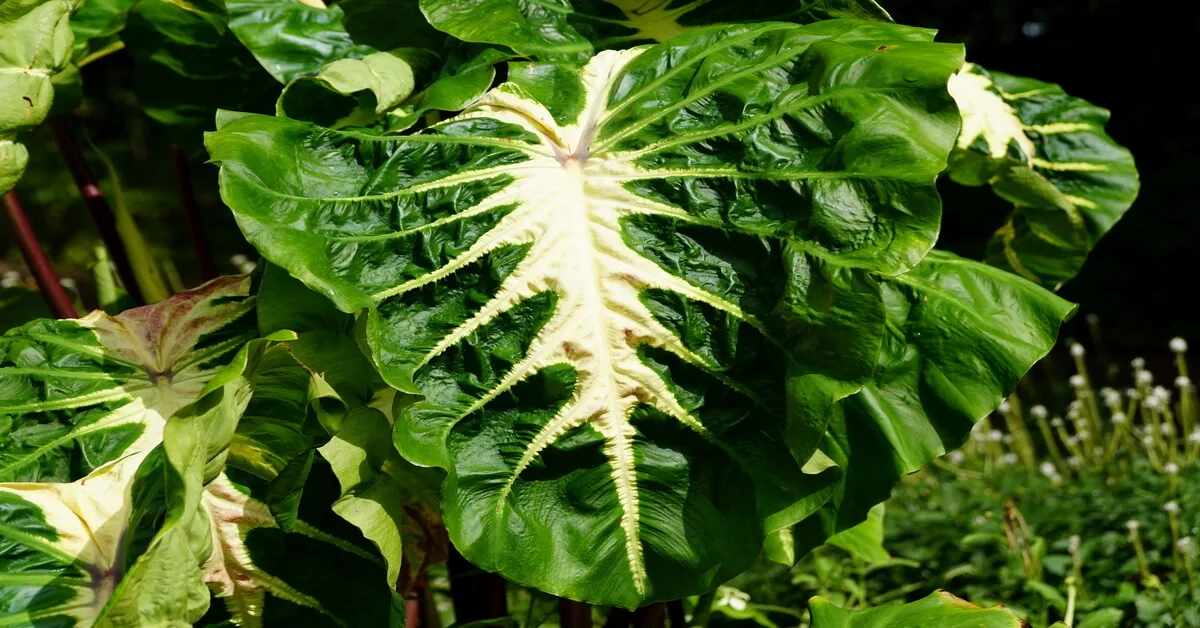Colocasia ‘Light Pillar’ is a tuberous, clump-forming, perennial in the Araceae family. Other common names include elephant ear and taro plant. They grow up to 4 feet tall and 3 feet wide.
The origin of Colocasia ‘Light Pillar’ is the tropics of eastern Asia. They grow naturally along swampy areas as semi-aquatic plants. Their large, heart-shaped leaves have areas of pink, yellow, and green.
In this article, we’ll tell you all about how to successfully grow and care for this beautiful plant.
Colocasia esculenta ‘Light Pillar’ Care
Colocasia ‘Light Pillar’ can be grown indoors or outdoors when temperatures are above 60 degrees Fahrenheit. They require a lot of moisture so make sure to water them frequently.
They are fairly disease and pest resistant which makes them easier to care for. They grow best when given plenty of bright, indirect sunlight.
Soil
Plant Colocasia esculenta ‘Light Pillar’ in well-draining, moisture-retentive soil. It grows best in soil that has plenty of organic matter.
The pH should be slightly acidic to neutral (6.0 to 7.0).
Watering
Colocasia ‘Light Pillar’ loves water. They can actually be planted in up to 6 inches of standing water without issue. Make sure to keep their soil moist by watering plants at least once per week.
Lighting
Colocasia ‘Light Pillar’ grows best in bright, indirect sunlight. It will grow in lower light settings but bright light improves its growth rate. Direct, afternoon sun can scald and damage the leaves.
Humidity & Temperature
These tropical plants love humidity. Feel free to place them near a humidifier or place them in a tray of water to increase humidity.
They aren’t frost tolerant, so they must be brought indoors during winter. They grow best when temperatures are between 60 and 80 degrees Fahrenheit.
Fertilizing
Use a liquid fertilizer once a month in spring and summer. Make sure it has equal parts nitrogen, phosphorus, and potassium. Don’t fertilize during fall and winter when it goes dormant.
Propagation
To propagate Colocasia ‘Light Pillar’ you’ll need to divide the root tubers. Remove the parent plant from its pot. Gently remove the soil until you can see the tubers.
Divide the tubers and repot your newly propagated plants. It’s best to propagate new plants in spring or summer when they’re actively growing.
Diseases & Pests
Colocasia esculenta ‘Light Pillar’ doesn’t have any serious disease or pest issues. They can be infested by common houseplant pests including spider mites, whiteflies, and aphids.
Prevent insect pest issues by ensuring any new plants you bring into the home are insect free.
Toxicity
Colocasia plants, including ‘Light Pillar’, are toxic to humans and pets. They contain calcium oxalate which can cause irritation if the sap gets on the skin. Wear protective gloves when pruning Colocasia esculenta.
If ingested, the calcium oxalate can cause irritation of the mouth and esophagus. Keep this plant out of reach of children, cats, and dogs.
Colocasia ‘Light Pillar’ vs Colocasia ‘White Lava’

The main difference between Colocasia ‘Light Pillar’ and Colocasia ‘White Lava’ is the foliage coloration. Colocasia ‘Light Pillar’ has a deep pink coloration surrounding the leaf midrib. The pink area has a border of yellow and the margins are green.
Colocasia ‘White Lava’ leaves have a solid white coloration around the midrib that radiates outwards.

